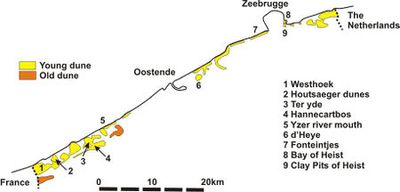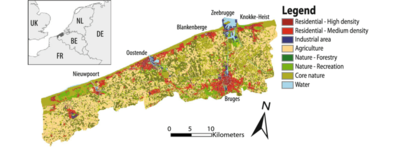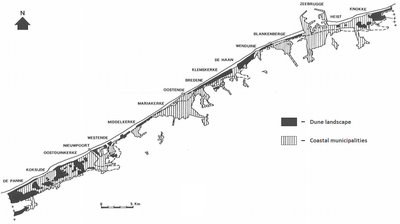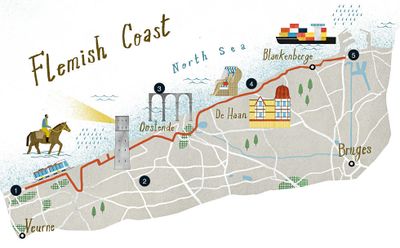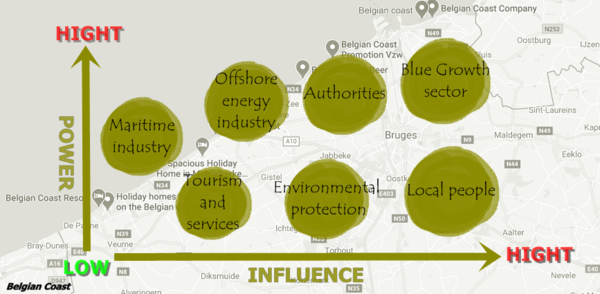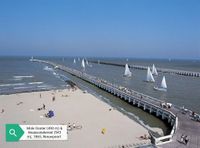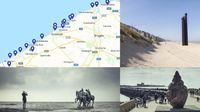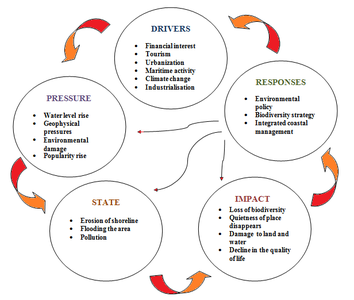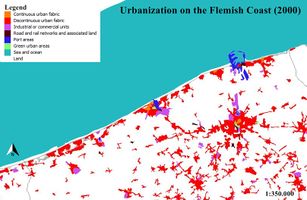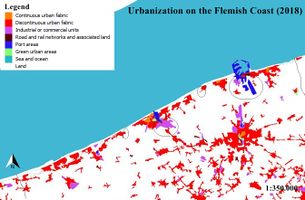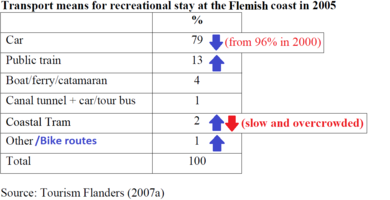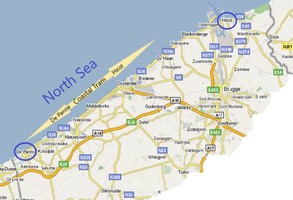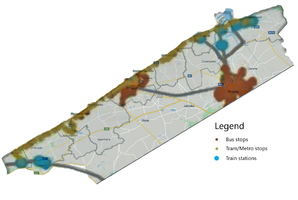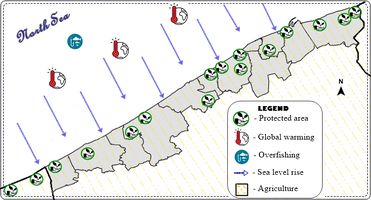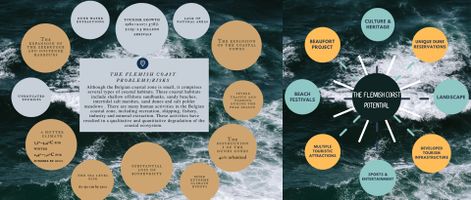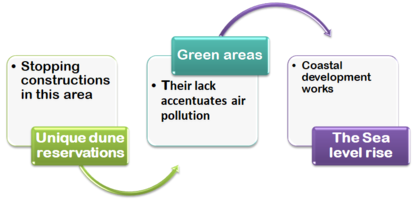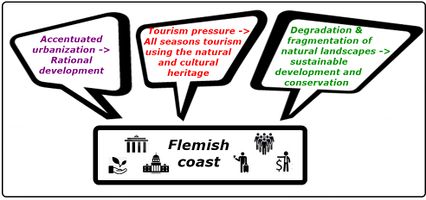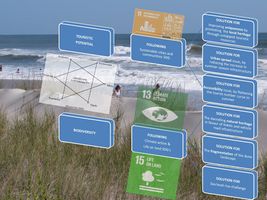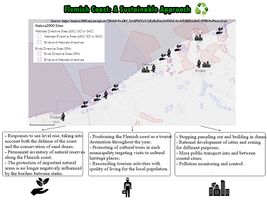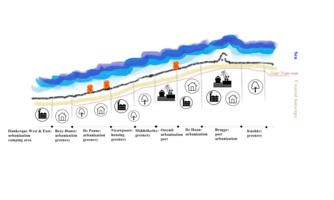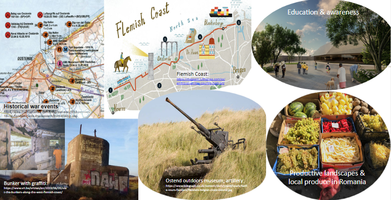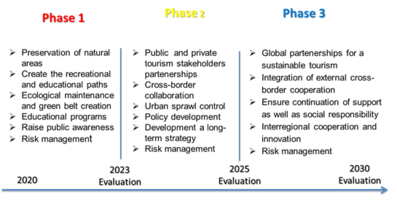COLAND Case Study 2020 - Belgian Coast: Difference between revisions
Alin.pricop (talk | contribs) |
|||
| (103 intermediate revisions by 5 users not shown) | |||
| Line 17: | Line 17: | ||
| '''Topics''' || style="background:Lavender"|''Geographical cross-cutting; Sustainable housing; Green and blue infrastructure'' | | '''Topics''' || style="background:Lavender"|''Geographical cross-cutting; Sustainable housing; Green and blue infrastructure'' | ||
|- | |- | ||
| '''Author(s)''' || style="background:Lavender"|''Andra Birica; Ruxandra Mihalcea; Alin Pricop | | '''Author(s)''' || style="background:Lavender"|''Andra Birica; Ruxandra Mihalcea; Alin Pricop; Ionela Popa; Mariana Bodea'' | ||
|- | |- | ||
| colspan="3" align="center" style="background:silver"| [[File:Belgia.png|400px]] | | colspan="3" align="center" style="background:silver"| [[File:Belgia.png|400px]] | ||
| Line 39: | Line 39: | ||
== A.1 Landscape layers and their system context == | == A.1 Landscape layers and their system context == | ||
=== Geomorphology, landscape units and coastal typology === | === Geomorphology, landscape units and coastal typology === | ||
<gallery caption=" " widths=" | The Belgian coast consists of sandy beaches formed from thousands of years of interaction from natural factors, while in the interior landward area presents an intertidal flat, that has been developed through deposition of intermittent peat formations and fine-grained material. The study area is composed of a number of “belts”, the important ones for our study being the coastal dune belt and the coastal plain. | ||
File: | |||
File: | Geologically speaking, the present-day coastal barrier and plain were shaped very recently, in the Holocene period, between 10000 and 5000 years ago, when a natural rise of sea level took place from the melting of the Weichselian ice caps, rising up to 16 meters from 5000 years ago to this day. | ||
Our study area has a significant number of young dunes, being mainly located in the western side of the coast, where a more wild landscape is prevalent. | |||
<gallery caption=" " widths="400px" heights="300px" perrow="5"> | |||
File:Geology.png|''Geophysiographic sketch map showing the 'belts' https://www.researchgate.net/figure/Geophysiographic-sketch-map-showing-the-belts-of-northern-France-and-Belgium-based-on_fig2_226781223'' | |||
File:Coastal_formation.png|''Geomorphology https://journals.openedition.org/belgeo/15994?lang=nl'' | |||
File:Dunes.jpg|''Dune formations http://www.coastalwiki.org/wiki/Sand_dune_-_Country_Report,_Belgium'' | |||
</gallery> | </gallery> | ||
=== Land use === | === Land use === | ||
The study area is represented by a dense urban area that overshadows the natural landscapes that consists of dunes and beaches on the sea side, and with agriculture and forestry the more we go inland. | |||
This chaotic development between the two elements have threatened with time the coastline’s health through it’s severe fragmentation and erosion. | |||
What was a tidal landscape of dunes and meandering creeks, turned into a linear system with polders and a seemingly endless asphalt jungle along the increasingly eroded shore. | |||
<gallery caption=" " widths="400px" heights="300px" perrow="5"> | |||
File:Flanders coast.png|''Belgian coast land use https://www.researchgate.net/publication/257480845_Effect_of_spatial_adaptation_measures_on_flood_risk_Study_of_coastal_floods_in_Belgium'' | |||
File:Dunes map.png|''Dune landscape fragmentation due to urban sprawl http://biblio.naturalsciences.be/rbins-publications/miscellanous/faunal-inventories-of-sites-for-cartography-and-nature-conservation-proceedings-of-the-8th-international-colloqium-of-the-european-invertebrate-survey/faunal-inventories-of-sites-for-cartography-and-nature-conservation_177-187.pdf'' | |||
File:Flemish coast.jpg|''The flemish coast with it's attractions https://magazin.lufthansa.com/content/uploads/2016/10/Karte_Flandern_Zahlen-980x607.jpg'' | |||
</gallery> | </gallery> | ||
=== Green/blue infrastructure === | === Green/blue infrastructure === | ||
Green and blue infrastructure is particularly important because it has an impact on the environmental, social and economic level. This infrastructure can be encountered in various places, such as natural or semi-natural, urban, rural or marine areas. It can also include natural or man-made elements. On the Belgian coast the major potential elements of blue-green infrastructure network are represented by numerous natural and artificial parks, nature reserves and small lakes spread along the coastal area. Blue infrastructure is less represented than green infrastructure, meeting here Teteghem Lake, Spuikom, Vargeul, and other small lakes and canals. | Green and blue infrastructure is particularly important because it has an impact on the environmental, social and economic level. This infrastructure can be encountered in various places, such as natural or semi-natural, urban, rural or marine areas. It can also include natural or man-made elements. On the Belgian coast the major potential elements of blue-green infrastructure network are represented by numerous natural and artificial parks, nature reserves and small lakes spread along the coastal area. Blue infrastructure is less represented than green infrastructure, meeting here Teteghem Lake, Spuikom, Vargeul, and other small lakes and canals. | ||
| Line 84: | Line 90: | ||
=== Sacred spaces and heritage === | === Sacred spaces and heritage === | ||
The coast of Belgium includes many heritage sites and areas of great historical importance, highlighted by statues, churches, memorial houses, forts, walkways, military vessels left over from activity, museums with special collections and many others. But the most representative element is a natural one, namely the sand dunes. Sand dunes have formed along the full length of the Belgian coastline (65 km) as a part of the dune barriers between Dunquerque (Northern France) and Denmark, originally covering over 6,000 ha. Today, only 3,800 ha of sand dunes remain, while nearly 50% of the coastline has been urbanised. The coast comprises a very gently sloping beach of fine sand backed by dunes generally less than 20m high, their width varying from a few kilometres (at De Panne and east of Knokke) to less than one hundred metres. They include Older Dunes of mid-Holocene age bordered and partly overlapped by Younger Dunes, which are still forming. The sequence is related to successive marine transgressions and regressions, during which a broad intertidal flat became bordered by barrier islands on which the dunes formed. | |||
The coast of Belgium has 9 natural dunes reserves, with approved management plans, but their implementation is blocked by the rapid development of road and tourism infrastructure. | |||
An important tradition included in the UNESCO list, which is still practiced today is Shrimp fishing on horseback in Oostduinkerke. In this 500-year-old tradition, shrimp fishermen dressed in yellow raincoats and high boots ride their horses breast-deep into the water at low tide. The horse pulls a net and drags a chain through the sand. Vibrations created by the chain rattle the shrimps into jumping into the net. The catch is then deposited into baskets fastened to the saddle. | |||
Horse-riding shrimpers demonstrate their craft during the annual Shrimp Festival of Oostduinkerke in the last weekend of June. The event, which attracts over 10,000 visitors a year, also features a shrimp parade and a shrimp catching contest for kids. | |||
<gallery caption=" " widths="200px" heights="150px" perrow="5"> | <gallery caption=" " widths="200px" heights="150px" perrow="5"> | ||
| Line 95: | Line 105: | ||
=== Visual appearance and landscape narrative === | === Visual appearance and landscape narrative === | ||
Landscape character is defined as the distinct, recognisable and consistent pattern of elements in the landscape. It it these patterns that give each locality its 'sense of place', making one landscape different from another. Physical elements provide the fundamentally stable basic pattern of landscape, while cultural elements are superimposed on this and are more fluid, reflecting social and land use changes over time. Layered on top of this is the perceptual element – our own personal appreciation of landscape and how we relate to or make use of it, as individuals and communities. | Landscape character is defined as the distinct, recognisable and consistent pattern of elements in the landscape. It it these patterns that give each locality its 'sense of place', making one landscape different from another. Physical elements provide the fundamentally stable basic pattern of landscape, while cultural elements are superimposed on this and are more fluid, reflecting social and land use changes over time. Layered on top of this is the perceptual element – our own personal appreciation of landscape and how we relate to or make use of it, as individuals and communities. | ||
| Line 104: | Line 111: | ||
An important project is taking place on the coast of Belgium, named Beaufort - an art project, triennial, in which the main role is played by the sea, an uncontrollable but unifying place. Every participating artist comes from a country that borders on the sea, which creates monuments that have different symbolisms, such as honoring characters who have made a significant contribution to society, illustrating tragic events or the connection between nature and man. The first edition of Beaufort took place in 2003 and was organised by then director of the Ostend Provincial Museum for Modern Art Willy Van den Bussche who would also remain the triennial’s curator in 2006. Monumental works found their place against the unique backdrop of the Coast, resulting in embodying the relationship between society and the environment and paying homage to both past times and events, as well as to the supremacy of the sea. | An important project is taking place on the coast of Belgium, named Beaufort - an art project, triennial, in which the main role is played by the sea, an uncontrollable but unifying place. Every participating artist comes from a country that borders on the sea, which creates monuments that have different symbolisms, such as honoring characters who have made a significant contribution to society, illustrating tragic events or the connection between nature and man. The first edition of Beaufort took place in 2003 and was organised by then director of the Ostend Provincial Museum for Modern Art Willy Van den Bussche who would also remain the triennial’s curator in 2006. Monumental works found their place against the unique backdrop of the Coast, resulting in embodying the relationship between society and the environment and paying homage to both past times and events, as well as to the supremacy of the sea. | ||
For example, on the beaches of De Panne, Nieuwpoort and Oostende have been raised monuments that symbolize the power of people and nature. | For example, on the beaches of De Panne, Nieuwpoort and Oostende have been raised monuments that symbolize the power of people and nature. | ||
"Three Wise Noses of De Panne” are part of a tradition of realistic public sculptures that have a heroic function, like the Statue of Liberty in New York Harbor, the Cristo Redentor in Rio De Janeiro or the ancient Colossus of Rhodes. They stand there as protectors or guardian angels of all seafarers, as symbolic defenders of a harbour or coastal city. They are statues that initially served as a welcome beacon or signpost, and over time have become tourist attractions, no longer just a waymark but a destination in their own right. | "Three Wise Noses of De Panne” are part of a tradition of realistic public sculptures that have a heroic function, like the Statue of Liberty in New York Harbor, the Cristo Redentor in Rio De Janeiro or the ancient Colossus of Rhodes. They stand there as protectors or guardian angels of all seafarers, as symbolic defenders of a harbour or coastal city. They are statues that initially served as a welcome beacon or signpost, and over time have become tourist attractions, no longer just a waymark but a destination in their own right. "Men" is an equestrian sculpture that is part of an ancient Belgian tradition of placing equestrian monuments on the coast. Men on horses represent power and war. By putting them in the unusual setting of the sea and echoing the motif, the element of prestige is replaced by drama, and the statues look as if one moment in a forgotten battle at sea has been cast in bronze. This allusion to an army absurdly draws lines across time and place, as the statues disappear and reappear with the tide. A daily vanishing ritual as the ocean slowly swallows the sharp edges of the sculptures until they eventually disappear into anonymity. | ||
The "Monument for a Wullok" is a monument to the sea, and ode to its power and indomitable nature, and to the secrets that it refuses to reveal. The bronze thus acquires a brownish-green pockmarked surface which contrasts with the soft, smooth and accessible inner side, in which as children we thought we could hear the sound of the sea. | The "Monument for a Wullok" is a monument to the sea, and ode to its power and indomitable nature, and to the secrets that it refuses to reveal. The bronze thus acquires a brownish-green pockmarked surface which contrasts with the soft, smooth and accessible inner side, in which as children we thought we could hear the sound of the sea. | ||
The coast of Belgium has been immortalized in postcards since 1926, but also in books describing both the historical events in this area and its tourist secrets. | The coast of Belgium has been immortalized in postcards since 1926, but also in books describing both the historical events in this area and its tourist secrets. | ||
| Line 131: | Line 137: | ||
</gallery> | </gallery> | ||
== A.3 Theory reflection == | |||
As the area is characterized by rapid urbanization as a consequence of population growth, the Belgian coast faces challenges such as climate change, economic development, demographic changes and environmental resource management. Climate change is already affecting the marine environment and will continue to trigger changes in biological, chemical and physical processes. Such changes can reduce the ‘ecosystem resilience’ (i.e. the ability of an ecosystem to persist despite disruption and change) to other man-induced pressures, leaving ecosystems increasingly sensitive to disruption. Impacts include rising sea levels, increased sea temperatures and precipitation changes. The New Urban Agenda as guidance for further integrated urban development can facilitate mitigation of the problems such as urban sprawl, losing the identity of the space, unsustainable resource use and lack of participation, mainly through the dialog between multi-stakeholders (public and private sector, working with civil society). | |||
In 2000, Florence was the host of the European Landscape Convention, which recognized the importance of the landscape, defining it as part of the lands perceived by both locals and visitors and evolving over time as a result of natural forces and human actions. The purpose of the convention was to promote the protection, planning and management of European landscapes and to establish a form of cooperation on landscape issues. Another key aspect of the convention is that it assigns an active role to the public in terms of landscape perception and evaluation. The public should be directly involved, not just specialists, therefore, the objectives regarding the quality of the landscape are set by the aspirations of the public and by the characteristics of the landscape, surroundings that are formulated in addition by the competent authorities. In our case, Belgian coast has all kinds of landscapes whose importance has been recognized by this convention. | |||
In 2010, Belgium adopted its National Adaptation Strategy which describes the main climate change impacts, the existing adaptation responses, a roadmap to a future National Adaptation Plan (NAP) and several policy guidelines for the further development of adaptation policy. The Strategy has 3 objectives: improve consistency between existing adaptation activities in Belgium (evaluation of the impacts of climate change, vulnerability to climate change and adaptation measures already implemented); improve communication at national, European and international levels; initiate a process for the preparation of a national action plan. The Belgian National Adaptation Plan targets the years 2017-2020 and proposes a set of national measures focused on adaptation to climate change. | |||
== A.4 References == | == A.4 References == | ||
* COLAND online seminar | |||
* https://www.google.ro/maps/@51.1937049,2.727344,63300m/data=!3m1!1e3 | * https://www.google.ro/maps/@51.1937049,2.727344,63300m/data=!3m1!1e3 | ||
* http://chapter.ser.org/europe/files/2012/08/Coastal.dunes_.Westhoek-2008-excursion.pdf | * http://chapter.ser.org/europe/files/2012/08/Coastal.dunes_.Westhoek-2008-excursion.pdf | ||
| Line 149: | Line 154: | ||
* https://ec.europa.eu/environment/nature/ecosystems/docs/Green_Infrastructure.pdf | * https://ec.europa.eu/environment/nature/ecosystems/docs/Green_Infrastructure.pdf | ||
* http://bioveins.eu/blog/article2 | * http://bioveins.eu/blog/article2 | ||
* https://www.beaufort2018.be/en | |||
* https://www.beaufort2018.be/en/artworks | |||
* https://www.belgiancoast.co.uk/en/do/culture-heritage | |||
* http://www.worcestershire.gov.uk/info/20014/planning/1006/landscape_character_assessment | |||
* https://www.climat.be/files/4214/9880/5755/NAP_EN.pdf | |||
* http://www.flanderstoday.eu/current-affairs/climate-change-requires-radical-plan-flemish-coast | |||
* http://landezine.com/ | |||
* Geldof, Charlotte and Zaman, Jan (2015) Some Futures for the Belgian Coast 2100, a Case Study of Research by Design on Regional Level. REAL CORP 2015 | |||
* https://brussels-express.eu/13-fascinating-belgian-traditions-recognized-as-unesco-cultural-legacies/ | |||
* http://www.coastalwiki.org/wiki/Sand_dune_-_Country_Report,_Belgium | |||
= Phase B: Landscape Evaluation and Assessment = | = Phase B: Landscape Evaluation and Assessment = | ||
== B.1 Assessment Strategy == | == B.1 Assessment Strategy == | ||
GOALS: | |||
1. Preventing urban sprawl in the development of urbanization is important to showcase for understanding the fact that urban sprawl does not show significant issues expansion-wise in the | |||
outside the built-up area, but rather the decrease and degradation of the green areas in the urban space in favor of gray infrastructure. | |||
2. Addressing overcrowding in the summer by developing around-the-year tourist attractions and infrastructure through less developed potentials like the bunkers and the local heritage/identity. | |||
3. Reducing the impact of habitat loss and fragmentation, global warming, pollution and coastal construction through sustainable development and nature conservation. | |||
== B.2 Mapping == | == B.2 Mapping == | ||
*''As defined by your assessment strategy you conduct the mapping and present your findings here'' | *''As defined by your assessment strategy you conduct the mapping and present your findings here'' | ||
*''As a minimum, at least three different themes need to be mapped, you may choose more if needed'' | *''As a minimum, at least three different themes need to be mapped, you may choose more if needed'' | ||
'''Urbanization on the Flemish Coast map:''' | |||
Through the two maps, it can be obseved a comparison of the Flemish coast over 18 years in terms of urban development. So, the difference are: | |||
*The port (wich is colored with blue) and urban fabric ( with red) in Brugge have expanded over the years; | |||
*Urban fabric have expanded in area De Haan and Niewpoort; | |||
*Industrial and commercial units (with violet) increased in Ostend; | |||
*The extra-villain space is the same, but its development is defective through urban expansion; | |||
The coast is quite urbanized, there are very few spaces that are occupied by the extra-villain, which is a problem for the inhabitants, tourism and protected areas. | |||
'''Tourism infrastructure & tendencies:''' | |||
As in many coastal touristic areas affected by rampant urbanization, the Flemish coast has an overcrowding problem that appears in the summer (''transport means for recreational stay chart''). | |||
The road infrastructure is well developed (''main accessibility infrastructure map'') and improved in the past decades in terms of sustainability through the reduction in car transportation and the increase of bike and public transportation. With these changes, the pressure of an increasing population has been manageable in comparison to other similar cases in different EU countries (''main agglomerations map''), but as the urbanization trends show us, the transport means change isn’t enough to maintain a sustainable future. | |||
A solution for this would be to expand the touristic season by developing less used touristic potentials (WW2 remains, spas) and revert the damage done from the prevalence of the mass products in the touristic areas, and the reintroduction of regional products, thus solving the problem of disappearing identity and uniqueness of our study area (''disappearing identity schematic''), complementing the existing cultural heritage. | |||
'''Nature conservation map:''' | |||
On the Flemish coast we find special natural elements, such as sand dunes, lakes, sand marshes but also a great diversity in terms of biodiversity (numerous species of animals and plants). The most representative natural element of the Flemish coast are the sand dunes, including older dunes of the mid-Holocene age and younger dunes, which are still forming. In the past they occupied about 6000 ha, but due to the fact that almost 50% of the coastline was urbanized, and also due to fragmentation, the area covered by sand dunes has been reduced to 3800 ha. The sand dunes in this region were damaged more than in other countries, so the Flemish Parliament approved the decree on the protection of the coastal dunes in 1993, and since then, this intensive coastal conservation policy has led to the development of an ecosystem perspective for the Flemish coast. Between 1998 and 2007, 10 new regional nature reserves were designated and several management plans were approved by the Flemish authorities. | |||
Currently on the Flemish coast there are numerous protected areas, with smaller or larger surfaces, many of them being integrated in the Natura 2000 Network. The most important protected areas were represented on Nature conservation map, these being (from west to east): Wind Park; National Nature Reserve of the Dune Marchand; Nature Reserve of Westhoek; Doornpanne; Veldbatterij De Bamburg; De Warandeduinen; Keignaert Nature; Paelsteenpanne; Spanjaardduin; Duinbossen; Put van Vlissegem; Uitkerkse Polders; The fountains; Park 58; Zwindunes Et Polders; The Zwin. Most of the rest of the territory (except the built areas) is used for agricultural purposes, also being part of the green infrastructure network and having economic importance. | |||
On the map we have also represented that global warming and rising temperatures will lead to a faster sea level rise (by 2100 it is expected to increase by 60-90 cm). This would radically change the landscape of the coastal area because much of it is at low altitudes or even below sea level. Rising sea level will lead to degradation of sand dunes and habitats in this area, polders also being extremely vulnerable to global warming. Biodiversity in the North Sea is also affected by overfishing, increased pollution, eutrophication (an increased load of land-based nutrients - N, Si, P), sand and aggregate extraction, coastal construction, harbor works, recreation and also storage of WWI chemical weapons (about 100 to 500 tons of toxic material is estimated to be present in the east of Zeebrugge). | |||
In the future, all these problems cannot be completely eliminated, but they can be reduced by a systemic and integrated approach of all the factors that act on the Flemish coast. The main objective is to achieve a sustainable development, which takes into account both economic development and nature protection, without threatening the safety of future generations. | |||
<gallery caption=" " widths="500px" heights="200px" perrow="1"> | <gallery caption=" " widths="500px" heights="200px" perrow="1"> | ||
File: | File:BG 2000.jpeg |''Urbanization on the Flemish Coast in 2000'' | ||
File: | File:BC 2018.jpeg |''Urbanization on the Flemish Coast after 18 years (2018)'' | ||
File: | File:Transport_chart.png| ''Transport means for recreational stay'' | ||
File:Transport_flemish_coast.png| ''Main accessibility infrastructure'' | |||
File:Road_infrastructure.png|''Main agglomerations linked to transit type'' | |||
File:Schema_turism.png|''Disappearing identity schematic'' | |||
File:Flemish coast protected areas.jpg|''Nature conservation map - here are represented the most important protected areas, these being (from west to east): Wind Park; National Nature Reserve of the Dune Marchand; Nature Reserve of Westhoek; Doornpanne; Veldbatterij De Bamburg; De Warandeduinen; Keignaert Nature; Paelsteenpanne; Spanjaardduin; Duinbossen; Put van Vlissegem; Uitkerkse Polders; The fountains; Park 58; Zwindunes Et Polders; The Zwin.'' | |||
File:Problems flemish coast.jpg|''Reducing the problems of the Flemish coast through sustainable development and nature conservation'' | |||
</gallery> | </gallery> | ||
== B.3 Problem definition and priority setting == | == B.3 Problem definition and priority setting == | ||
<gallery caption=" " widths="500px" heights="200px" perrow="5"> | <gallery caption=" " widths="500px" heights="200px" perrow="5"> | ||
File: | File:90146548 987827771614847 4692498370722267136 n.jpg|''The Flemish coast problems/risks and potential'' | ||
File:90150169 523123645274551 7492886256817274880 n.png|''The Flemish coast priorities and targets'' | |||
File:899989877654.jpg|''Problems and solutions of the Flemish coast'' | |||
</gallery> | </gallery> | ||
Although the Belgian coastal zone is small, it comprises several types of coastal habitats (sandy beaches, intertidal salt marshes, sand dunes and salt polder meadows) and is a densely populated area and hence a very intensively used zone with important economic and tourist activities. Furthermore, the Belgian Part of the North Sea (including the exclusive economic zone) is characterized by high productivity, but also by dense shipping traffic, intensive fisheries, tourism, the presence of cables and pipelines, sand and gravel extraction, dredging activities, and offshore wind turbine parks. These activities have resulted in a qualitative and quantitative degradation of the coastal ecosystem. | |||
The main problems of the Flemish coast are classified into 4 categories: Climate change, Loss of biodiversity, Tourism growth and Development of coastal cities. | |||
* Climate change affects the coast through advanced erosion, sea level rise, extreme weather events that cause flooding. | |||
* The loss of biodiversity is mainly the cause of the protection measures taken by the authorities through the construction of the dams, but also a cause of urban overdevelopment, of the tourism in a chaotic way, of the constructions in the protected areas. | |||
* The Flemish coast is the most popular holiday destination in the country, therefore, it greatly affects the coastal area, due to the fact that many tourists cross the beaches destroying dunes, throwing waste and polluting. Also, for a pleasant stay, the authorities are building access roads, beach bars and other tourist structures that destroy habitats. | |||
* Due to the high demand of tourists to spend their holidays in the Flemish coastal area, the coastal cities have developed considerably, occupying more and more of the natural areas and building accommodation, recreation and parking spaces and golf courses. | |||
Regarding the potential of the Flemish coast, it consists of the diversity of cultural tourist attractions (statues, museums, exhibitions, unique and unique monuments), social (festivals, concerts), sports, culinary, but also in the large number of different tourist structures. vacation packages and relaxation opportunities. The main motivation for a coastal visit is to relax (48%) and enjoy the healthy sea air (45%). In terms of activities, strolling on the dike (70%), visiting cafes, tea rooms, terraces (57%) and visiting restaurants (44%) Moreover, the Belgian coast is popular with water sports enthusiasts. | |||
'''Priorities for the most relevant issues:''' | |||
The priorities for the most relevant issues can be: | |||
* conservation of sand dunes as an integral and unique part of the landscape; | |||
* reducing environmental pollution by maintaining green spaces; | |||
* coastal development works to capitalize on the economic and tourism potential for a long term, in the context of global warming. | |||
== B.4 Theory reflection == | == B.4 Theory reflection == | ||
In order to analyze the Flemish coast area, we have focused on three main problems to map, these being: the accentuated urbanization; the pressure of tourism, especially in summer; degradation of natural ecosystems and fragmentation of areas with sand dunes. To make the maps, we used different programs, such as QGIS, PhotoScape and Paint 3D, obtaining Development of urbanization map, Tourism infrastructure & tendencies map and Nature conservation map. The main solutions to these problems are rational development, the promotion of all seasons tourism using the natural and especially cultural heritage (because it is not sufficiently exploited from tourism point of view in the Flemish coastal area), and the conservation of nature (especially the sand dunes, that have an important value for the Flemish coast, and which are now increasingly threatened with extinction, fragmentation and also coastal construction and erosion), along with a sustainable development that will take into account the well-being of future generations. | |||
In the elaboration of this project we encountered some limitations, such as: the difficulty of finding information and understanding the real situation, without making field observations on the Flemish coast; insufficient knowledge about mapping programs; the difficulty of observing differences over time on large scale maps; lack of language skills. | |||
== B.5 References == | == B.5 References == | ||
* ' | |||
* COLAND online seminar; | |||
* Cliquet A. Coastal Zone Management in Belgium. In: Revue Juridique de l'Environnement, numéro spécial, 2001. Aménagement et gestion intégrée des zones côtières. pp. 85-106; | |||
* De Ruyck, A.M.C., Ampe, C. & Langohr, R. J Coast Conserv (2001): Management of the belgian coast: Opinions and solutions | |||
* http://www.kustportaal.be/en/tourism-and-recreation | |||
* Transport types: https://www.researchgate.net/profile/Freke_Caset/publication/317013653/figure/fig4/AS:613921723527171@1523381753177/Overview-of-all-Flemish-and-Brussels-PT-nodes-included-in-the-calculations.png | |||
* Road map of Flanders: https://www.insightairquality.com/2017/04/waar-vind-ik-informatie-over.html | |||
* Andre de Vries; "Flanders: A Cultural History (Landscapes of the Imagination)" Hardcover – June 11, 2007 | |||
* https://www.natuurenbos.be/sites/default/files/inserted-files/cl_1.3_provoost.pdf | |||
* http://www.coastalwiki.org/wiki/Sand_dune_-_Country_Report,_Belgium | |||
* https://ec.europa.eu/environment/life/project/Projects/index.cfm?fuseaction=search.dspPage&n_proj_id=102 | |||
* https://baltcoastinline.databases.eucc-d.de/files/000105_EUROSION_De_Haan.pdf | |||
* Biodiversity of the Belgian marine areas, Francis Kerckhof, Jean-Sebastien Houziaux | |||
=Phase C – Strategy and Master Plan = | =Phase C – Strategy and Master Plan = | ||
== C.1 Goal Setting == | == C.1 Goal Setting == | ||
Since our project encompasses the Flemish Coast as a whole, our objectives are thought in a more broad planning. Thus, we identified from the information we gathered the main issues that have the potential to be changed through 2 goals that reflect sustainable developement, which are: | |||
• Tapping into underdeveloped tourist attractions (the necessary monetary incentive through sustainable cities and communities SDG), answering the accessibility and pollution problem that bring strain on the locals and the municipality respectively, by flattening out and spreading the annual curve of tourist numbers in summer, while bringing more uniqueness to our study area and reducing chaotic urban sprawl without fully restricting it through legislation. | |||
• Biodiversity goal (climate action and life on land SDG’s), answering parts of the sea-level rise challenge (though it will still require some artificial infrastructure) and helping save from fragmentation the dwindling natural heritage of the area (that also has alternative tourism attraction potential). | |||
'''Our vision:''' | |||
The title of our project is Flemish Coast: A Sustainable Approach. This project includes especially solutions regarding urbanization, tourism and natural landscapes, but also others. In terms of natural landscapes, we must consider the following aspects: responses to sea level rise, taking into account both the defense of the coast and the conservation of sand dunes; permanent inventory of natural reserves along the Flemish Coast; the protection of important natural areas it should no longer be influenced by the borders between states. In terms of tourism, our project aims: positioning the Flemish coast as a tourist destination throughout the year; promoting of cultural tours in each municipality targeting visits to cultural heritage places; reconciling tourism activities with quality of living for the local population. Regarding urbanization, the following aspects are indicated: stopping parceling out and building in dunes; rational development of cities and zoning for different purposes; more public transport into and between coastal cities; pollution monitoring and control. | |||
<gallery caption=" " widths="500px" heights="200px" perrow="1"> | <gallery caption=" " widths="500px" heights="200px" perrow="1"> | ||
File: | File:Dune turisti 22.jpg| ''Our goals and means to accomplish them'' | ||
File: | File:Spatial vision Flemish coast.jpg|''Flemish Coast: A Sustainable Approach'' | ||
File: | File:transectBC.png|''Flemish Coast Transect'' | ||
File: | File:Accupuncture biodiversity.png|''Acupuncture & interventions towards biodiversity goal '' | ||
File:Acupuncture tourism.png|''Touristic potential & accessibility; Off-season encouragement'' | |||
</gallery> | </gallery> | ||
== C.3 From Theory of Change to Implementation == | == C.3 From Theory of Change to Implementation == | ||
* | |||
* Which partnerships are needed? | |||
The institutions responsible for the management of the coastal zone are highly fragmented and include three levels of governance (federal, regional and local). The competences in the coastal zone are divided between the federal government (the marine part of the coastal zone) and the Flemish Region (most matters on the landward side of the coastal zone and some matters at sea, such as dredging). | |||
Most adaptation initiatives will be undertaken by local, regional or federal authorities in the context of their own climate policy. National measures aim to complement regional measures by promoting greater coordination and information-sharing between the authorities. | |||
* Which governance model is required? | |||
As governance model we choose The National Adaptation Plan who describes national measures for the next few years, covering the period 2017-2020. For each national measure, information is given on: the entity(ies) in charge (e.g. responsible for implementation and financing – where needed) ; the actors involved in the implementation (non-exhaustive list - consultations with all relevant stakeholders will take place as appropriate); an initial estimation of the budget (where appropriate); the planning. This plan is separated into 11 measures, each one promising to solve the environmental problems caused especially by the climatic change: climate change, climate adaptation, the effect of invasive species on the marine environment, the effect of climate change on the energy resources, the socio-economic effects of the climate, the achievement of one of the future Nationaln Environmenta l Health Action Plan, educating the population on climate change and protecting the environment, promoting transnational collaborations. | |||
These measures, collaborations between stakeholders, population, NGOs and local administrations, can also have an effect on the beneficial development of cities, by implementing rules that protect the coastal environment against both the population and tourists, as well as the climate action on it. | |||
<gallery caption=" " widths="500px" heights="200px" perrow="1"> | <gallery caption=" " widths="500px" heights="200px" perrow="1"> | ||
File: | File:92438113 167289474420848 3177258991302475776 n.png|''The Flemish Coast - Partnerships and Governance'' | ||
File: | File:Timeline Flanders.png|''Our process model'' | ||
</gallery> | </gallery> | ||
Since our project has a more broad approach, we decided on a three-step plan that focuses on sustainability. | |||
The initial action is prioritized towards education, awareness, creating a path through the green landscapes. Also, there will always be the risk of failing to collaborate between actors, at any of the phases. | |||
On our mid-term solution, there will be implementations of local projects, in the hopes to control chaotic urban sprawl and maintain a healthy tourism development, while thinking about how to implement a long-term strategy in terms of funds, projects and collaboration options. | |||
In the long-term, we will put into action the sustainable model that will work also on threats such as the rising sea level and balancing nature’s and economy’s needs through cooperation and innovation. | |||
== C.4 References == | == C.4 References == | ||
* | |||
* COLAND online seminar | |||
* Road map of the Flemish Coast: https://www.insightairquality.com/2017/04/waar-vind-ik-informatie-over.html | |||
* Dune landscape: https://whyy.org/wp-content/uploads/2019/09/AP_19263661194945-e1569200515933.jpg | |||
* Dune restoration: https://ec.europa.eu/environment/nature/natura2000/platform/documents/life_platform_dunes/day3/life_dunes_14_life_flandre_belgium_herrier_en.pdf | |||
* Bunker with grafitti: https://www.vrt.be/vrtnws/en/2019/06/09/visit-the-bunkers-along-the-west-flemish-coast/ | |||
* Bunker interior: https://bunkerdag.nl/en/page/bunkerdag-belgie | |||
* War events on the Flemish coast: https://www.themapcentre.com/the-great-war-1914-18-ngi-flanders-fields-the-western-front-8546-p.asp | |||
* Artillery image from outdoor museum in the study area: https://www.telegraph.co.uk/content/dam/travel/Spark/battle-tours-flanders/flanders-belgian-coast-ostend.jpg | |||
* Touristic map of Flanders: https://magazin.lufthansa.com/xx/en/travel-en/low-country-high-art/ | |||
* https://natura2000.eea.europa.eu/?fbclid=IwAR3_Ssu8PMXwS2yKaRoEmaSu9MnL4nc6Jk0KDyat8sEr0PBh9wPmaoxlvoo | |||
* https://ec.europa.eu/environment/nature/natura2000/platform/documents/life_platform_dunes/day3/life_dunes_14_life_flandre_belgium_herrier_en.pdf?fbclid=IwAR31hkpXi1AJcuP3lbxJeQVkOhZTSgG38E1OMrVdx59d-DP6jLMzXueY1yU | |||
* https://europeforvisitors.com/europe/articles/flemish_coast.htm | |||
* De Ruyck, A.M.C., Ampe, C. & Langohr, R. J Coast Conserv (2001): Management of the belgian coast: Opinions and solutions | |||
* Sustainable Tourism Development by Applying the Learning Area Concept in the North Sea Region: Challenge Profiles – Belgian case, GHENT UNIVERSITY Faculty of Bio-Science Engineering Department Agricultural Economics | |||
* Cliquet A. Coastal Zone Management in Belgium. In: Revue Juridique de l'Environnement, numéro spécial, 2001. Aménagement et gestion intégrée des zones côtières. pp. 85-106 | |||
* Belgian National Adaptation Plan 2017-2020 | |||
= D. Process Reflection = | = D. Process Reflection = | ||
| Line 223: | Line 342: | ||
*''You can also use diagrams/visuals'' | *''You can also use diagrams/visuals'' | ||
*''250 words text'' | *''250 words text'' | ||
The '''outcomes''' of our study are represented by a better knowledge of the Flemish coast, identification of the main issues in the area such as accentuated urbanization, tourism pressure, degradation and fragmentation of natural landscapes, and also implementation of strategies and solutions for these problems. | |||
In this project '''we have learned''' many important and necessary things for our development. We have learned that for an efficient sustainable development of the coastal area, all territorial factors and actors must be involved, and also in order to reach the true potential of the coastal area we must study it in detail. | |||
We encountered some '''limitations''', such as: the difficulty of finding information and understanding the real situation, without making field observations; the insufficient knowledge about mapping programs; the fact that our team was not an interdisciplinary one (this led to a more geographical approach); the lack of language skills. | |||
There are a few '''things that we would do differently next time''' like to discuss more, to manage our time better and to give more time to the case study. | |||
It is vital for us to know the coastal areas as well as possible, because these areas are special and they offer us a lot of possibilities. The Flemish coast is such a place, and it was very beneficial to study it and get to know it better as part of this course. All this informations will be very beneficial in the future in studying other coastal areas, and maybe we will be able to contribute directly to their sustainable development. | |||
---- | ---- | ||
[[Category:Coastal Landscapes Case Study 2020]] | [[Category:Coastal Landscapes Case Study 2020]] | ||
[[Category:Coastal Landscapes Case Study]] | [[Category:Coastal Landscapes Case Study]] | ||
Latest revision as of 10:41, 9 April 2020
>>>back to working groups overview
Rationale
One of Belgium’s smaller regions is Flanders, which in turn brings a grand resource for the country: it’s serene coast towards the North Sea, with 68 km in lenght, consisting of a gently sloping sandy beach, backed by coastal dunes. With time, erroneous planning and climate change in the area made people realize of the long-term risks. Thus, we must adapt and correct the challenges of rapid urbanization, urban sprawl, erosion and the rising sea level, balancing and uniting 1- the protection of the cultural and natural heritage with 2- economical gains from the productive landscapes and tourism.
Location and scope
You can edit this map with the map editor
A Landscape System Analysis
A.1 Landscape layers and their system context
Geomorphology, landscape units and coastal typology
The Belgian coast consists of sandy beaches formed from thousands of years of interaction from natural factors, while in the interior landward area presents an intertidal flat, that has been developed through deposition of intermittent peat formations and fine-grained material. The study area is composed of a number of “belts”, the important ones for our study being the coastal dune belt and the coastal plain.
Geologically speaking, the present-day coastal barrier and plain were shaped very recently, in the Holocene period, between 10000 and 5000 years ago, when a natural rise of sea level took place from the melting of the Weichselian ice caps, rising up to 16 meters from 5000 years ago to this day.
Our study area has a significant number of young dunes, being mainly located in the western side of the coast, where a more wild landscape is prevalent.
Geophysiographic sketch map showing the 'belts' https://www.researchgate.net/figure/Geophysiographic-sketch-map-showing-the-belts-of-northern-France-and-Belgium-based-on_fig2_226781223
Geomorphology https://journals.openedition.org/belgeo/15994?lang=nl
Land use
The study area is represented by a dense urban area that overshadows the natural landscapes that consists of dunes and beaches on the sea side, and with agriculture and forestry the more we go inland. This chaotic development between the two elements have threatened with time the coastline’s health through it’s severe fragmentation and erosion. What was a tidal landscape of dunes and meandering creeks, turned into a linear system with polders and a seemingly endless asphalt jungle along the increasingly eroded shore.
Dune landscape fragmentation due to urban sprawl http://biblio.naturalsciences.be/rbins-publications/miscellanous/faunal-inventories-of-sites-for-cartography-and-nature-conservation-proceedings-of-the-8th-international-colloqium-of-the-european-invertebrate-survey/faunal-inventories-of-sites-for-cartography-and-nature-conservation_177-187.pdf
The flemish coast with it's attractions https://magazin.lufthansa.com/content/uploads/2016/10/Karte_Flandern_Zahlen-980x607.jpg
Green/blue infrastructure
Green and blue infrastructure is particularly important because it has an impact on the environmental, social and economic level. This infrastructure can be encountered in various places, such as natural or semi-natural, urban, rural or marine areas. It can also include natural or man-made elements. On the Belgian coast the major potential elements of blue-green infrastructure network are represented by numerous natural and artificial parks, nature reserves and small lakes spread along the coastal area. Blue infrastructure is less represented than green infrastructure, meeting here Teteghem Lake, Spuikom, Vargeul, and other small lakes and canals.
The green infrastructure is represented by National Nature Reserve the Dune Marchand, Doornpanne Park, Maria Hendrikapark, Zeebos Park, Westhoek Nature Reserve, Sint-Pietersplas Park, Zwin Nature Park, etc., but also includes elements such as hedgerows, copses, bushes , orchards, woodlands, natural grasslands. Many of the natural parks have protection status and are integrated in the Natura 2000 Network due to the sand dunes and the special forests of the coastal area, among other elements of biodiversity. An important element of green infrastructure is agriculture, which covers an important area of the Belgian coast and which is essential for economic growth.
The main functions of the green-blue infrastructure are related to the conservation of biodiversity and the protection of ecosystems, the development of a sustainable economy and the promotion of health and wellbeing for the local communities, achieving a sustainable management of the area and maintaining a balance between the ecological functions and the multi-functional use of the lands.
All this elements representing the green and blue infrastructure are unlikely to disappear in the near future because most of them have natural landscape elements or represent important elements of the landscape, economy and society.
Actors and stakeholders
- The main actors who play an important role in the coast of Belgium are politicians (authorities), entrepreneurs (energy and maritime industry) naturalist (environmental protection) and local people.A considerable power and influence is exercised by the authorities and industry because they make decisions without implicating the other actors.Those who are affected but with the least power are the naturalists because the coast is in a continuous degradation (especially construction of polders and uncontrolled agriculture affects the environment). Local people are ignored and badly treated, they do not have power but are very affected by the decisions of the others actors involved in the development of the coast. The biggest changes in the Belgian coast are made by urbanization products because tall buildings are built quite close to the beach and invades the protected areas. The tourism in development has effects on the coast because it has a low quality. Tourists set up tents illegally in protected areas and pollute the environment, leaving waste behind.The main problems on the coast of Belgium are produced by the powerful actors and for this bad influence Belgium has adopted since 2009 Blue Growth, supported by the EU. Blue Growth focuses more on the economic development of all sectors on the coast and less on protecting the environment.
Sacred spaces and heritage
The coast of Belgium includes many heritage sites and areas of great historical importance, highlighted by statues, churches, memorial houses, forts, walkways, military vessels left over from activity, museums with special collections and many others. But the most representative element is a natural one, namely the sand dunes. Sand dunes have formed along the full length of the Belgian coastline (65 km) as a part of the dune barriers between Dunquerque (Northern France) and Denmark, originally covering over 6,000 ha. Today, only 3,800 ha of sand dunes remain, while nearly 50% of the coastline has been urbanised. The coast comprises a very gently sloping beach of fine sand backed by dunes generally less than 20m high, their width varying from a few kilometres (at De Panne and east of Knokke) to less than one hundred metres. They include Older Dunes of mid-Holocene age bordered and partly overlapped by Younger Dunes, which are still forming. The sequence is related to successive marine transgressions and regressions, during which a broad intertidal flat became bordered by barrier islands on which the dunes formed. The coast of Belgium has 9 natural dunes reserves, with approved management plans, but their implementation is blocked by the rapid development of road and tourism infrastructure. An important tradition included in the UNESCO list, which is still practiced today is Shrimp fishing on horseback in Oostduinkerke. In this 500-year-old tradition, shrimp fishermen dressed in yellow raincoats and high boots ride their horses breast-deep into the water at low tide. The horse pulls a net and drags a chain through the sand. Vibrations created by the chain rattle the shrimps into jumping into the net. The catch is then deposited into baskets fastened to the saddle. Horse-riding shrimpers demonstrate their craft during the annual Shrimp Festival of Oostduinkerke in the last weekend of June. The event, which attracts over 10,000 visitors a year, also features a shrimp parade and a shrimp catching contest for kids.
Visual appearance and landscape narrative
Landscape character is defined as the distinct, recognisable and consistent pattern of elements in the landscape. It it these patterns that give each locality its 'sense of place', making one landscape different from another. Physical elements provide the fundamentally stable basic pattern of landscape, while cultural elements are superimposed on this and are more fluid, reflecting social and land use changes over time. Layered on top of this is the perceptual element – our own personal appreciation of landscape and how we relate to or make use of it, as individuals and communities.
An important project is taking place on the coast of Belgium, named Beaufort - an art project, triennial, in which the main role is played by the sea, an uncontrollable but unifying place. Every participating artist comes from a country that borders on the sea, which creates monuments that have different symbolisms, such as honoring characters who have made a significant contribution to society, illustrating tragic events or the connection between nature and man. The first edition of Beaufort took place in 2003 and was organised by then director of the Ostend Provincial Museum for Modern Art Willy Van den Bussche who would also remain the triennial’s curator in 2006. Monumental works found their place against the unique backdrop of the Coast, resulting in embodying the relationship between society and the environment and paying homage to both past times and events, as well as to the supremacy of the sea. For example, on the beaches of De Panne, Nieuwpoort and Oostende have been raised monuments that symbolize the power of people and nature. "Three Wise Noses of De Panne” are part of a tradition of realistic public sculptures that have a heroic function, like the Statue of Liberty in New York Harbor, the Cristo Redentor in Rio De Janeiro or the ancient Colossus of Rhodes. They stand there as protectors or guardian angels of all seafarers, as symbolic defenders of a harbour or coastal city. They are statues that initially served as a welcome beacon or signpost, and over time have become tourist attractions, no longer just a waymark but a destination in their own right. "Men" is an equestrian sculpture that is part of an ancient Belgian tradition of placing equestrian monuments on the coast. Men on horses represent power and war. By putting them in the unusual setting of the sea and echoing the motif, the element of prestige is replaced by drama, and the statues look as if one moment in a forgotten battle at sea has been cast in bronze. This allusion to an army absurdly draws lines across time and place, as the statues disappear and reappear with the tide. A daily vanishing ritual as the ocean slowly swallows the sharp edges of the sculptures until they eventually disappear into anonymity. The "Monument for a Wullok" is a monument to the sea, and ode to its power and indomitable nature, and to the secrets that it refuses to reveal. The bronze thus acquires a brownish-green pockmarked surface which contrasts with the soft, smooth and accessible inner side, in which as children we thought we could hear the sound of the sea. The coast of Belgium has been immortalized in postcards since 1926, but also in books describing both the historical events in this area and its tourist secrets.
A.2 Summary of your landscape system analysis and your development targets
- Tourism, urbanization, maritime activity, climate change, industrialization are the main drivers on the Belgian coast. That driver is exerting pressure on the area. The results of these pressures can be considered negative because there are effects such as the increase of the water level, the geophysical pressure, the deterioration of the environment, the popularity of the area. Also, there are effects on the environment, such as erosion of shoreline, flooding area, pollution (air by industry, audio by construction of various buildings, environment by tourism, and water by maritime industry). All this force has a negative impact, so the quietness of place disappears, land and water are damaged, and biodiversity will lose and decline in the quality of life.To stop the negative impact on the Belgian coast we thought that the Belgian state could have the following answers to the problems: a biodiversity strategy resulting by creating an integrated coastal management, environmental policy an efficient nature protection and conservation plan, strict application of structural plans and rules, nature restoration (integration of coast and polder) and strict control of tourism.
- Link back to the Sustainable Development Goals: Which goals are at risk?
- What is your hypothesis for this landscape?
- Visualise your hypothesis with one graphic/pict
- Are there any existing initiatives taking action in this landscape? Do you have a critical perspective on that?
- Add text and visuals
A.3 Theory reflection
As the area is characterized by rapid urbanization as a consequence of population growth, the Belgian coast faces challenges such as climate change, economic development, demographic changes and environmental resource management. Climate change is already affecting the marine environment and will continue to trigger changes in biological, chemical and physical processes. Such changes can reduce the ‘ecosystem resilience’ (i.e. the ability of an ecosystem to persist despite disruption and change) to other man-induced pressures, leaving ecosystems increasingly sensitive to disruption. Impacts include rising sea levels, increased sea temperatures and precipitation changes. The New Urban Agenda as guidance for further integrated urban development can facilitate mitigation of the problems such as urban sprawl, losing the identity of the space, unsustainable resource use and lack of participation, mainly through the dialog between multi-stakeholders (public and private sector, working with civil society).
In 2000, Florence was the host of the European Landscape Convention, which recognized the importance of the landscape, defining it as part of the lands perceived by both locals and visitors and evolving over time as a result of natural forces and human actions. The purpose of the convention was to promote the protection, planning and management of European landscapes and to establish a form of cooperation on landscape issues. Another key aspect of the convention is that it assigns an active role to the public in terms of landscape perception and evaluation. The public should be directly involved, not just specialists, therefore, the objectives regarding the quality of the landscape are set by the aspirations of the public and by the characteristics of the landscape, surroundings that are formulated in addition by the competent authorities. In our case, Belgian coast has all kinds of landscapes whose importance has been recognized by this convention.
In 2010, Belgium adopted its National Adaptation Strategy which describes the main climate change impacts, the existing adaptation responses, a roadmap to a future National Adaptation Plan (NAP) and several policy guidelines for the further development of adaptation policy. The Strategy has 3 objectives: improve consistency between existing adaptation activities in Belgium (evaluation of the impacts of climate change, vulnerability to climate change and adaptation measures already implemented); improve communication at national, European and international levels; initiate a process for the preparation of a national action plan. The Belgian National Adaptation Plan targets the years 2017-2020 and proposes a set of national measures focused on adaptation to climate change.
A.4 References
- COLAND online seminar
- https://www.google.ro/maps/@51.1937049,2.727344,63300m/data=!3m1!1e3
- http://chapter.ser.org/europe/files/2012/08/Coastal.dunes_.Westhoek-2008-excursion.pdf
- https://ec.europa.eu/environment/nature/ecosystems/docs/green_infrastructure_integration.pdf
- https://ec.europa.eu/environment/nature/ecosystems/docs/Green_Infrastructure.pdf
- http://bioveins.eu/blog/article2
- https://www.beaufort2018.be/en
- https://www.beaufort2018.be/en/artworks
- https://www.belgiancoast.co.uk/en/do/culture-heritage
- http://www.worcestershire.gov.uk/info/20014/planning/1006/landscape_character_assessment
- https://www.climat.be/files/4214/9880/5755/NAP_EN.pdf
- http://www.flanderstoday.eu/current-affairs/climate-change-requires-radical-plan-flemish-coast
- http://landezine.com/
- Geldof, Charlotte and Zaman, Jan (2015) Some Futures for the Belgian Coast 2100, a Case Study of Research by Design on Regional Level. REAL CORP 2015
- https://brussels-express.eu/13-fascinating-belgian-traditions-recognized-as-unesco-cultural-legacies/
- http://www.coastalwiki.org/wiki/Sand_dune_-_Country_Report,_Belgium
Phase B: Landscape Evaluation and Assessment
B.1 Assessment Strategy
GOALS:
1. Preventing urban sprawl in the development of urbanization is important to showcase for understanding the fact that urban sprawl does not show significant issues expansion-wise in the outside the built-up area, but rather the decrease and degradation of the green areas in the urban space in favor of gray infrastructure.
2. Addressing overcrowding in the summer by developing around-the-year tourist attractions and infrastructure through less developed potentials like the bunkers and the local heritage/identity.
3. Reducing the impact of habitat loss and fragmentation, global warming, pollution and coastal construction through sustainable development and nature conservation.
B.2 Mapping
- As defined by your assessment strategy you conduct the mapping and present your findings here
- As a minimum, at least three different themes need to be mapped, you may choose more if needed
Urbanization on the Flemish Coast map:
Through the two maps, it can be obseved a comparison of the Flemish coast over 18 years in terms of urban development. So, the difference are:
- The port (wich is colored with blue) and urban fabric ( with red) in Brugge have expanded over the years;
- Urban fabric have expanded in area De Haan and Niewpoort;
- Industrial and commercial units (with violet) increased in Ostend;
- The extra-villain space is the same, but its development is defective through urban expansion;
The coast is quite urbanized, there are very few spaces that are occupied by the extra-villain, which is a problem for the inhabitants, tourism and protected areas.
Tourism infrastructure & tendencies:
As in many coastal touristic areas affected by rampant urbanization, the Flemish coast has an overcrowding problem that appears in the summer (transport means for recreational stay chart).
The road infrastructure is well developed (main accessibility infrastructure map) and improved in the past decades in terms of sustainability through the reduction in car transportation and the increase of bike and public transportation. With these changes, the pressure of an increasing population has been manageable in comparison to other similar cases in different EU countries (main agglomerations map), but as the urbanization trends show us, the transport means change isn’t enough to maintain a sustainable future.
A solution for this would be to expand the touristic season by developing less used touristic potentials (WW2 remains, spas) and revert the damage done from the prevalence of the mass products in the touristic areas, and the reintroduction of regional products, thus solving the problem of disappearing identity and uniqueness of our study area (disappearing identity schematic), complementing the existing cultural heritage.
Nature conservation map:
On the Flemish coast we find special natural elements, such as sand dunes, lakes, sand marshes but also a great diversity in terms of biodiversity (numerous species of animals and plants). The most representative natural element of the Flemish coast are the sand dunes, including older dunes of the mid-Holocene age and younger dunes, which are still forming. In the past they occupied about 6000 ha, but due to the fact that almost 50% of the coastline was urbanized, and also due to fragmentation, the area covered by sand dunes has been reduced to 3800 ha. The sand dunes in this region were damaged more than in other countries, so the Flemish Parliament approved the decree on the protection of the coastal dunes in 1993, and since then, this intensive coastal conservation policy has led to the development of an ecosystem perspective for the Flemish coast. Between 1998 and 2007, 10 new regional nature reserves were designated and several management plans were approved by the Flemish authorities.
Currently on the Flemish coast there are numerous protected areas, with smaller or larger surfaces, many of them being integrated in the Natura 2000 Network. The most important protected areas were represented on Nature conservation map, these being (from west to east): Wind Park; National Nature Reserve of the Dune Marchand; Nature Reserve of Westhoek; Doornpanne; Veldbatterij De Bamburg; De Warandeduinen; Keignaert Nature; Paelsteenpanne; Spanjaardduin; Duinbossen; Put van Vlissegem; Uitkerkse Polders; The fountains; Park 58; Zwindunes Et Polders; The Zwin. Most of the rest of the territory (except the built areas) is used for agricultural purposes, also being part of the green infrastructure network and having economic importance.
On the map we have also represented that global warming and rising temperatures will lead to a faster sea level rise (by 2100 it is expected to increase by 60-90 cm). This would radically change the landscape of the coastal area because much of it is at low altitudes or even below sea level. Rising sea level will lead to degradation of sand dunes and habitats in this area, polders also being extremely vulnerable to global warming. Biodiversity in the North Sea is also affected by overfishing, increased pollution, eutrophication (an increased load of land-based nutrients - N, Si, P), sand and aggregate extraction, coastal construction, harbor works, recreation and also storage of WWI chemical weapons (about 100 to 500 tons of toxic material is estimated to be present in the east of Zeebrugge).
In the future, all these problems cannot be completely eliminated, but they can be reduced by a systemic and integrated approach of all the factors that act on the Flemish coast. The main objective is to achieve a sustainable development, which takes into account both economic development and nature protection, without threatening the safety of future generations.
Nature conservation map - here are represented the most important protected areas, these being (from west to east): Wind Park; National Nature Reserve of the Dune Marchand; Nature Reserve of Westhoek; Doornpanne; Veldbatterij De Bamburg; De Warandeduinen; Keignaert Nature; Paelsteenpanne; Spanjaardduin; Duinbossen; Put van Vlissegem; Uitkerkse Polders; The fountains; Park 58; Zwindunes Et Polders; The Zwin.
B.3 Problem definition and priority setting
Although the Belgian coastal zone is small, it comprises several types of coastal habitats (sandy beaches, intertidal salt marshes, sand dunes and salt polder meadows) and is a densely populated area and hence a very intensively used zone with important economic and tourist activities. Furthermore, the Belgian Part of the North Sea (including the exclusive economic zone) is characterized by high productivity, but also by dense shipping traffic, intensive fisheries, tourism, the presence of cables and pipelines, sand and gravel extraction, dredging activities, and offshore wind turbine parks. These activities have resulted in a qualitative and quantitative degradation of the coastal ecosystem. The main problems of the Flemish coast are classified into 4 categories: Climate change, Loss of biodiversity, Tourism growth and Development of coastal cities.
- Climate change affects the coast through advanced erosion, sea level rise, extreme weather events that cause flooding.
- The loss of biodiversity is mainly the cause of the protection measures taken by the authorities through the construction of the dams, but also a cause of urban overdevelopment, of the tourism in a chaotic way, of the constructions in the protected areas.
- The Flemish coast is the most popular holiday destination in the country, therefore, it greatly affects the coastal area, due to the fact that many tourists cross the beaches destroying dunes, throwing waste and polluting. Also, for a pleasant stay, the authorities are building access roads, beach bars and other tourist structures that destroy habitats.
- Due to the high demand of tourists to spend their holidays in the Flemish coastal area, the coastal cities have developed considerably, occupying more and more of the natural areas and building accommodation, recreation and parking spaces and golf courses.
Regarding the potential of the Flemish coast, it consists of the diversity of cultural tourist attractions (statues, museums, exhibitions, unique and unique monuments), social (festivals, concerts), sports, culinary, but also in the large number of different tourist structures. vacation packages and relaxation opportunities. The main motivation for a coastal visit is to relax (48%) and enjoy the healthy sea air (45%). In terms of activities, strolling on the dike (70%), visiting cafes, tea rooms, terraces (57%) and visiting restaurants (44%) Moreover, the Belgian coast is popular with water sports enthusiasts.
Priorities for the most relevant issues:
The priorities for the most relevant issues can be:
- conservation of sand dunes as an integral and unique part of the landscape;
- reducing environmental pollution by maintaining green spaces;
- coastal development works to capitalize on the economic and tourism potential for a long term, in the context of global warming.
B.4 Theory reflection
In order to analyze the Flemish coast area, we have focused on three main problems to map, these being: the accentuated urbanization; the pressure of tourism, especially in summer; degradation of natural ecosystems and fragmentation of areas with sand dunes. To make the maps, we used different programs, such as QGIS, PhotoScape and Paint 3D, obtaining Development of urbanization map, Tourism infrastructure & tendencies map and Nature conservation map. The main solutions to these problems are rational development, the promotion of all seasons tourism using the natural and especially cultural heritage (because it is not sufficiently exploited from tourism point of view in the Flemish coastal area), and the conservation of nature (especially the sand dunes, that have an important value for the Flemish coast, and which are now increasingly threatened with extinction, fragmentation and also coastal construction and erosion), along with a sustainable development that will take into account the well-being of future generations.
In the elaboration of this project we encountered some limitations, such as: the difficulty of finding information and understanding the real situation, without making field observations on the Flemish coast; insufficient knowledge about mapping programs; the difficulty of observing differences over time on large scale maps; lack of language skills.
B.5 References
- COLAND online seminar;
- Cliquet A. Coastal Zone Management in Belgium. In: Revue Juridique de l'Environnement, numéro spécial, 2001. Aménagement et gestion intégrée des zones côtières. pp. 85-106;
- De Ruyck, A.M.C., Ampe, C. & Langohr, R. J Coast Conserv (2001): Management of the belgian coast: Opinions and solutions
- http://www.kustportaal.be/en/tourism-and-recreation
- Transport types: https://www.researchgate.net/profile/Freke_Caset/publication/317013653/figure/fig4/AS:613921723527171@1523381753177/Overview-of-all-Flemish-and-Brussels-PT-nodes-included-in-the-calculations.png
- Road map of Flanders: https://www.insightairquality.com/2017/04/waar-vind-ik-informatie-over.html
- Andre de Vries; "Flanders: A Cultural History (Landscapes of the Imagination)" Hardcover – June 11, 2007
- https://www.natuurenbos.be/sites/default/files/inserted-files/cl_1.3_provoost.pdf
- http://www.coastalwiki.org/wiki/Sand_dune_-_Country_Report,_Belgium
- https://ec.europa.eu/environment/life/project/Projects/index.cfm?fuseaction=search.dspPage&n_proj_id=102
- https://baltcoastinline.databases.eucc-d.de/files/000105_EUROSION_De_Haan.pdf
- Biodiversity of the Belgian marine areas, Francis Kerckhof, Jean-Sebastien Houziaux
Phase C – Strategy and Master Plan
C.1 Goal Setting
Since our project encompasses the Flemish Coast as a whole, our objectives are thought in a more broad planning. Thus, we identified from the information we gathered the main issues that have the potential to be changed through 2 goals that reflect sustainable developement, which are:
• Tapping into underdeveloped tourist attractions (the necessary monetary incentive through sustainable cities and communities SDG), answering the accessibility and pollution problem that bring strain on the locals and the municipality respectively, by flattening out and spreading the annual curve of tourist numbers in summer, while bringing more uniqueness to our study area and reducing chaotic urban sprawl without fully restricting it through legislation.
• Biodiversity goal (climate action and life on land SDG’s), answering parts of the sea-level rise challenge (though it will still require some artificial infrastructure) and helping save from fragmentation the dwindling natural heritage of the area (that also has alternative tourism attraction potential).
Our vision:
The title of our project is Flemish Coast: A Sustainable Approach. This project includes especially solutions regarding urbanization, tourism and natural landscapes, but also others. In terms of natural landscapes, we must consider the following aspects: responses to sea level rise, taking into account both the defense of the coast and the conservation of sand dunes; permanent inventory of natural reserves along the Flemish Coast; the protection of important natural areas it should no longer be influenced by the borders between states. In terms of tourism, our project aims: positioning the Flemish coast as a tourist destination throughout the year; promoting of cultural tours in each municipality targeting visits to cultural heritage places; reconciling tourism activities with quality of living for the local population. Regarding urbanization, the following aspects are indicated: stopping parceling out and building in dunes; rational development of cities and zoning for different purposes; more public transport into and between coastal cities; pollution monitoring and control.
C.3 From Theory of Change to Implementation
- Which partnerships are needed?
The institutions responsible for the management of the coastal zone are highly fragmented and include three levels of governance (federal, regional and local). The competences in the coastal zone are divided between the federal government (the marine part of the coastal zone) and the Flemish Region (most matters on the landward side of the coastal zone and some matters at sea, such as dredging). Most adaptation initiatives will be undertaken by local, regional or federal authorities in the context of their own climate policy. National measures aim to complement regional measures by promoting greater coordination and information-sharing between the authorities.
- Which governance model is required?
As governance model we choose The National Adaptation Plan who describes national measures for the next few years, covering the period 2017-2020. For each national measure, information is given on: the entity(ies) in charge (e.g. responsible for implementation and financing – where needed) ; the actors involved in the implementation (non-exhaustive list - consultations with all relevant stakeholders will take place as appropriate); an initial estimation of the budget (where appropriate); the planning. This plan is separated into 11 measures, each one promising to solve the environmental problems caused especially by the climatic change: climate change, climate adaptation, the effect of invasive species on the marine environment, the effect of climate change on the energy resources, the socio-economic effects of the climate, the achievement of one of the future Nationaln Environmenta l Health Action Plan, educating the population on climate change and protecting the environment, promoting transnational collaborations. These measures, collaborations between stakeholders, population, NGOs and local administrations, can also have an effect on the beneficial development of cities, by implementing rules that protect the coastal environment against both the population and tourists, as well as the climate action on it.
Since our project has a more broad approach, we decided on a three-step plan that focuses on sustainability.
The initial action is prioritized towards education, awareness, creating a path through the green landscapes. Also, there will always be the risk of failing to collaborate between actors, at any of the phases.
On our mid-term solution, there will be implementations of local projects, in the hopes to control chaotic urban sprawl and maintain a healthy tourism development, while thinking about how to implement a long-term strategy in terms of funds, projects and collaboration options.
In the long-term, we will put into action the sustainable model that will work also on threats such as the rising sea level and balancing nature’s and economy’s needs through cooperation and innovation.
C.4 References
- COLAND online seminar
- Road map of the Flemish Coast: https://www.insightairquality.com/2017/04/waar-vind-ik-informatie-over.html
- Dune landscape: https://whyy.org/wp-content/uploads/2019/09/AP_19263661194945-e1569200515933.jpg
- Dune restoration: https://ec.europa.eu/environment/nature/natura2000/platform/documents/life_platform_dunes/day3/life_dunes_14_life_flandre_belgium_herrier_en.pdf
- Bunker with grafitti: https://www.vrt.be/vrtnws/en/2019/06/09/visit-the-bunkers-along-the-west-flemish-coast/
- Bunker interior: https://bunkerdag.nl/en/page/bunkerdag-belgie
- War events on the Flemish coast: https://www.themapcentre.com/the-great-war-1914-18-ngi-flanders-fields-the-western-front-8546-p.asp
- Artillery image from outdoor museum in the study area: https://www.telegraph.co.uk/content/dam/travel/Spark/battle-tours-flanders/flanders-belgian-coast-ostend.jpg
- Touristic map of Flanders: https://magazin.lufthansa.com/xx/en/travel-en/low-country-high-art/
- https://natura2000.eea.europa.eu/?fbclid=IwAR3_Ssu8PMXwS2yKaRoEmaSu9MnL4nc6Jk0KDyat8sEr0PBh9wPmaoxlvoo
- https://ec.europa.eu/environment/nature/natura2000/platform/documents/life_platform_dunes/day3/life_dunes_14_life_flandre_belgium_herrier_en.pdf?fbclid=IwAR31hkpXi1AJcuP3lbxJeQVkOhZTSgG38E1OMrVdx59d-DP6jLMzXueY1yU
- https://europeforvisitors.com/europe/articles/flemish_coast.htm
- De Ruyck, A.M.C., Ampe, C. & Langohr, R. J Coast Conserv (2001): Management of the belgian coast: Opinions and solutions
- Sustainable Tourism Development by Applying the Learning Area Concept in the North Sea Region: Challenge Profiles – Belgian case, GHENT UNIVERSITY Faculty of Bio-Science Engineering Department Agricultural Economics
- Cliquet A. Coastal Zone Management in Belgium. In: Revue Juridique de l'Environnement, numéro spécial, 2001. Aménagement et gestion intégrée des zones côtières. pp. 85-106
- Belgian National Adaptation Plan 2017-2020
D. Process Reflection
- Reflect in your intercultural and interdisciplinary team on the outcomes of your study
- Which limitations were you facing?
- What have you learnt from each other?
- What would you do differently next time?
- You can also use diagrams/visuals
- 250 words text
The outcomes of our study are represented by a better knowledge of the Flemish coast, identification of the main issues in the area such as accentuated urbanization, tourism pressure, degradation and fragmentation of natural landscapes, and also implementation of strategies and solutions for these problems. In this project we have learned many important and necessary things for our development. We have learned that for an efficient sustainable development of the coastal area, all territorial factors and actors must be involved, and also in order to reach the true potential of the coastal area we must study it in detail. We encountered some limitations, such as: the difficulty of finding information and understanding the real situation, without making field observations; the insufficient knowledge about mapping programs; the fact that our team was not an interdisciplinary one (this led to a more geographical approach); the lack of language skills. There are a few things that we would do differently next time like to discuss more, to manage our time better and to give more time to the case study. It is vital for us to know the coastal areas as well as possible, because these areas are special and they offer us a lot of possibilities. The Flemish coast is such a place, and it was very beneficial to study it and get to know it better as part of this course. All this informations will be very beneficial in the future in studying other coastal areas, and maybe we will be able to contribute directly to their sustainable development.



